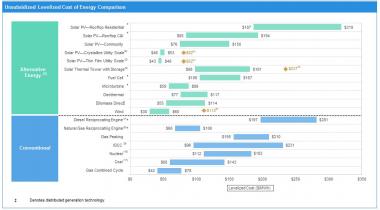US wind costs drop 6% in 2017; Germany installs 265-meter high turbine
Our pick of the latest wind power news you need to know.

Related Articles
North America wind costs fall 6% in 2017: Lazard
The levelized cost of energy (LCOE) for utility-scale wind power in North America has fallen by around 6% over the last year to between around $50/MWh, according to the latest annual cost analysis by Lazard consultancy.
Unsubsidized wind power costs now lie between $30 and $60/MWh depending on the region, Lazard said.
“The growing cost-competitiveness of certain alternative energy technologies globally reflects a number of factors, including lower financing costs, declining capital expenditures per project, improving competencies and increased industry competition,” George Bilicic, Vice Chairman and Global Head of Lazard’s Power, Energy & Infrastructure Group, said in a statement.
Levelized cost of energy by plant type
(Click image to enlarge)
Source: Lazard, November 2017.
While cost declines in utility scale wind and solar slowed "modestly" in 2017 the gap between renewable energy costs and conventional generation continues to widen as coal-fired generation costs remain flat and nuclear cost estimates rise, Lazard said.
"Specifically, the estimated levelized cost of energy for nuclear generation increased ~35% versus prior estimates, reflecting increased capital costs at various nuclear facilities currently in development," the consultancy said.
“Energy industry participants remain confident in the future of renewables, with new alternative energy projects generating electricity at costs that are now at or below the marginal costs of some conventional generation,” Jonathan Mir, Head of Lazard’s North American Power Group, said.
“The next frontier is energy storage, where continued innovation and declining costs are expected to drive increased deployment of renewables, which in turn will create more demand for storage,” he said.
Energy storage costs still vary widely between technologies and cost-competitive storage projects are limited to specific applications, Lazard noted.
However, energy storage costs are expected to fall significantly in the coming years, "driven by scale and related cost savings, improved standardization and technological improvements, supported in turn by increased demand as a result of regulatory/pricing innovation, increased renewables penetration and the needs of an aging and changing power grid," Lazard said.
For example, industry participants predict that lithium ion capital costs could fall by as much as 36% over the next five years, it said.
US Northeast could install 8 GW offshore wind by 2030: report
The U.S. Northeast could install up to 7.7 GW of offshore wind power capacity by 2030, according to a new report commissioned by the North East Wind Resource (NWRC) Centre.
The report estimated the potential for offshore wind deployment, taking into account wind resources, federal lease opportunities, state policies and regional energy needs.
A low regional deployment trajectory could lead to 4 GW of offshore wind power capacity by 2030, while a high trajectory could support up to 8 GW of new projects, NRWC said.
The low and high scenarios both presume some degree of policy intervention, it said.
NRWC highlighted the current policy support in place to support offshore wind, shown in the below table.
US North-East offshore wind procurement volumes
(Click image to enlarge)
Source: NWRC
Storage reservoir lifts turbine to record height
Max Bogl Wind has completed the installation of the world's tallest turbine, measuring some 264.5 meters high, at the Gaildorf wind farm in south-west Germany.
The turbine has a hub height of 178 m. A modern pump storage facility uses the foundation of the wind turbine as a water reservoir, which raises the height of the turbine by 40 m, Max Bogl Wind said in a statement.
"This is hugely beneficial since each additional meter of hub height added to a wind turbine increases the annual energy yield by 0.5 to 1 percent," the company said.
The Gaildorf wind farm consists of four turbines equipped with 3.4 MW GE generators, expected online in Spring 2018.
Larger turbines with higher efficiency rates are driving down the cost of onshore wind power.
The levelized cost of energy (LCOE) for utility-scale wind power in North America has fallen by around 6% over the last year to between around $50/MWh, according to the latest annual cost analysis by Lazard consultancy.
Wind experts predict the LCOE of onshore wind will fall a further 24% by 2030 as technology improvements drive a rapid increase in turbine capacity and hub height, according to an industry survey published by Berkeley Lab, the National Renewable Energy Laboratory (NREL) and University of Massachusetts in November 2016.
New Energy Update


